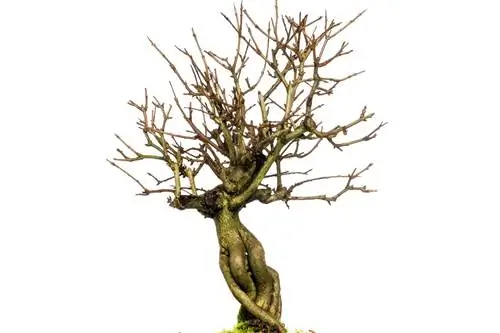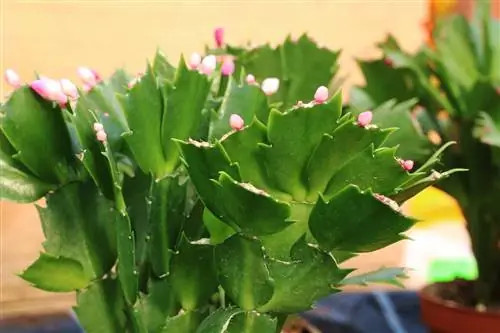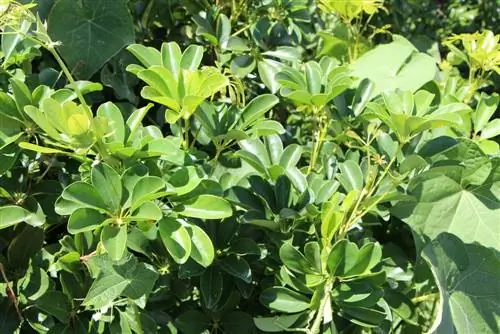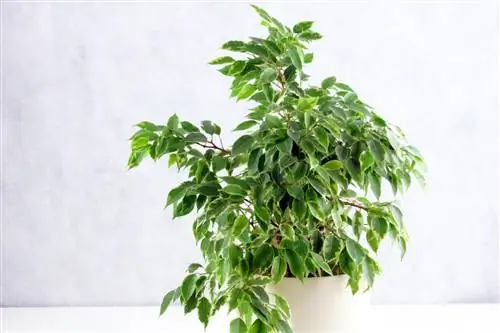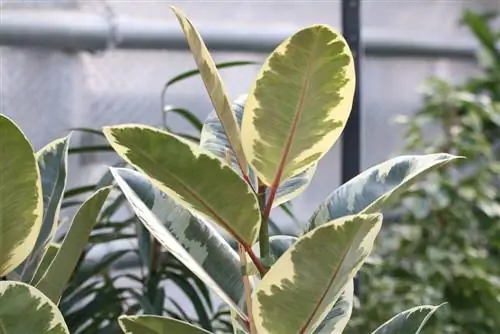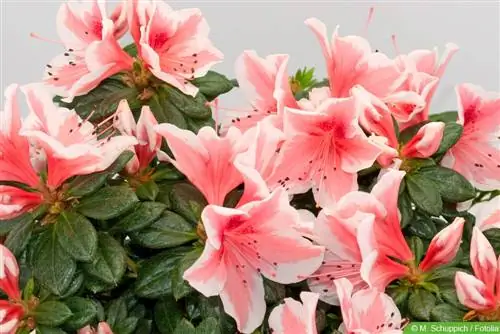- Author admin [email protected].
- Public 2023-12-17 03:39.
- Last modified 2025-01-24 12:45.
A bonsai by nature doesn't have it easy because it only has a very limited space available for its roots. In order for the plant to thrive, all other location, soil and care conditions must be met, otherwise the bonsai will quickly become ailing. The first sign that something is wrong is usually the shedding of large amounts of leaves. Something must now be done urgently so that the sensitive plant can recover and not die completely.
Care errors
A bonsai is a miniature version of the real plant. The corresponding plants, often huge trees in nature, only remain relatively small because their root growth is extremely limited. In addition, the shoots are trimmed at regular intervals and bent in desirable directions. Even as a bonsai, the plant requires the same conditions as in the wild. If it is a summer-green plant, it should also be allowed to rest in the winter as a bonsai. In most cases, there are no serious diseases that affect the bonsai and cause it to drop its leaves, but rather just care errors in general that can be easily remedied with a little expertise.
Not watered enough
With small planting bowls, where the roots and substrate often extend far beyond the top edge, it is not easy to supply the plant with enough water. In practice, in the vast majority of cases where a bonsai loses its leaves, a lack of water is to blame.
Measures
If the earth has a fairly solid surface, the bowl can be submerged. To do this, place the bowl in a container with water and wait until no more air bubbles appear. Then drain well. At normal room temperature, this process needs to be carried out about 1-2 times a week. Less in the winter months, sometimes daily in the summer depending on the temperature. If the soil is too loose, there is a risk that it will be washed away during diving. In these cases, spraying the root ball intensively with water is the better method. Spraying may only be stopped when the water runs out of the bottom opening of the pot (place the tub underneath).
Too much watered
Too much watering is usually only possible if the bonsai pot does not have an outlet in the bottom (often with inexpensive bonsai plants). If the root ball is permanently in water, root damage will occur. Therefore, the root ball should always be allowed to dry slightly between each watering.
Measures
The bonsai must be taken out of its pot and all soil carefully removed. In addition, rotten root parts must be cut off before adding fresh substrate. When it comes to the substrate, make sure that only really high-quality bonsai soil is used! Do not water for the next three to four days, then water more cautiously than before.
Lighting conditions are not right
As a rule, a bonsai wants abright place in the apartment. However, bright does not mean that the small - and also sensitive - tree stands under a roof window or on the windowsill in a south-facing window in summer. The midday sun creates extreme heat through the glass pane, which simply causes the bonsai to burn. A location that is too sunny can usually be recognized by the fact that the leaves that face the sunny side turn yellow, dry up or fall off.
Measures
In these cases, the only solution is to move it, either behind a protective curtain or to another window that only provides a few hours of direct sun in the morning or evening.
Of course, the location of the bonsai can also betoo shady. This can be easily recognized by the fact that the new shoots suddenly have a much brighter green than the remaining leaves and the distances between the individual leaves become significantly larger. When there is a lack of light, the bonsai forms so-called light shoots: Through increased growth, it tries to get back to regions where there is more light.
Measures
These shoots must be cut off at the base and the plant must be placed in a slightly brighter place (bright, but without direct sunlight!).
Humidity too low (heating air in winter)
Especially in winter, when the heating is turned on again, many bonsai plants in our rooms begin to shed all their leaves. If you look more closely, the bonsai may also be standing directly above the heater, so that the rising warm air constantly flows around it, heating up the root ball and thus drying out the entire plant.
Measures
In these cases, frequent spraying with water does not help; the bonsai must definitely be moved to a cooler room. A (sleeping) room that faces north or east is usually better than the living room for overwintering an evergreen bonsai. It's nice and bright there and usually a little cooler.
Wrong substrate
It is often noticed that an inexpensive bonsai from the supermarket is placed in a thick block of clay as a substrate. Here the roots can hardly spread and only get nutrients or air with great difficulty. A good bonsai soil always contains the following components:
- fine-grained clay soil (sifted)
- Sand
- lava granules
- Peat
- Humus
- as well as special additives for conifers, for example
Tip:
High-quality bonsai substrate can be purchased from specialist retailers. It usually contains everything the plant needs.
Too small pot (bowl)
The rule is: the roots of plants (regardless of whether they are bonsai or not) require approximately the same space that the crown of the tree takes up. If you look at many bonsais (sometimes even when you buy them), the pot is simply far too small. It's understandable that the restricted roots simply can no longer supply the lush crown with water and nutrients. For easy inspection, the bonsai can be lifted out of the pot with the entire root ball. If fine hair roots are already visible on the outside, repotting (and sometimes also a root cut) is urgently recommended.
Measures
In this case, cutting back the crown and repotting (with high-quality bonsai soil) into a slightly larger container are the two simple measures that can stop leaf loss.
Too much fertilizer
A bonsai can also lose its leaves if there are too high s alt levels in the soil. Anyone who has accidentally fertilized too often or in a concentration that is significantly too high must definitely do something promptly.
Measures
As a first aid measure, it is advisable to immerse the pot in clear water again so that the fertilizer can dilute. However, if a lot of leaves are already falling, the s alty soil must be removed and replaced with fresh substrate.
Pests
A bonsai reacts very sensitively to disturbances. If the amount of water is not right, if it is too light or dark, it weakens the plant enormously. Especially warm heating air in winter - and the associated low humidity - makes the bonsai susceptible to pests such as spider mites, which should be visible on the plant upon closer inspection.
Measures
Common remedies against sucking pests help here. However, urgent care must be taken to repeat the treatment after about 10 days, as this is when the second generation will hatch. In addition, the plant must be placed in a slightly cooler place with higher humidity (light).
Summer green plant
Many types of bonsai are grown from deciduous trees that lose their leaves in winter. If they are in the apartment, the shedding of leaves is often delayed. Some plants even retain their leaves almost all winter and then shed them in spring. However, these plants absolutely need a rest period in winter.
Measures
If you own such a plant, you should definitely make sure that the bonsai also loses its leaves in autumn. It is best to place it in a semi-shady place on the balcony or terrace over the summer and stay there until autumn, so that, like all trees in the garden, it loses its leaves at the first cool temperatures. Over the winter, a deciduous bonsai should definitely be kept cool and watered occasionally.
Bonsai care errors in brief
The art of bonsai is old and somewhat complicated. It is not easy to cultivate a bonsai. You can't say in general terms what causes a bonsai to lose its leaves. Of course, it may be that the plant did not receive enough water. But that is usually not the case. Most plant lovers tend to water their favorites too much. Hardly any plants die of thirst, many more die because they are too wet and the roots therefore rot.
Deciduous plant?
The question is rather what type of bonsai it is. There are also deciduous varieties, where it is normal for the leaves to become dry and fall off. These bonsai usually have to be kept cooler. They hibernate. You only water them a little. The colder they are, the less they need to be watered. Then there is no more fertilization. In spring they are warmed up again. Then they should be cast out.
Leaf fall due to draft?
Very few plants like drafts. Bonsai are no exception. Although most of them can be placed outside in the summer, if they are indoors you should be careful that they are not exposed to any drafts. If there is a pull, the leaves can dry out and then fall off. So, always pay attention to the location!
Location too dark?
Very few plants like dark locations. Depending on which tree you are cultivating as a bonsai, you have to find out where the best location is. It's best to think about whether you have the right place for the bonsai before you buy. They are like any plant; their success depends on their location and care. If a bonsai is kept too dark, it will usually shed a few leaves every day. Over time it no longer looks beautiful. As a rule, however, it is there if it is bright enough. It then sprouts again. Many bonsai are best placed right next to the window.
Too much water?
Most plants die if they are watered too generously. It's no different with bonsai. The soil dries out quickly in their shallow planters, but you also have to wait a while before watering again. It takes a bit of sensitivity.
Too much fertilizer?
If you fertilize a bonsai too much and it happens quite quickly, it tends to drop leaves. Deposits of minerals can be seen on the ground, usually on the trunk. Too much fertilizer and too much watering are often carried out at the same time. This is often a deadly combination for a bonsai.
Leaf loss after repotting?
Repotting, even if you do it according to the instructions for bonsai, is not without problems for many of the plants. Some plants are sensitive to root pruning. But they usually recover well from the cut and repotting and sprout again.
Location above heating?
Many bonsai that spend the winter in a warm place, for example in the living room, are placed on a window sill above a heater. No bonsai likes the draft of dry heating air. The location is unfavorable. If you don't have another one to choose from, place the tree on a tray that is filled with Hydro, Seramis or similar stones. These need to be moistened regularly. This creates your own moisture balance.
Editor’s Tip
If the bonsai has already lost a lot of leaves, the tree should be placed under a transparent plastic bag. The increased humidity causes the bonsai to sprout again.

